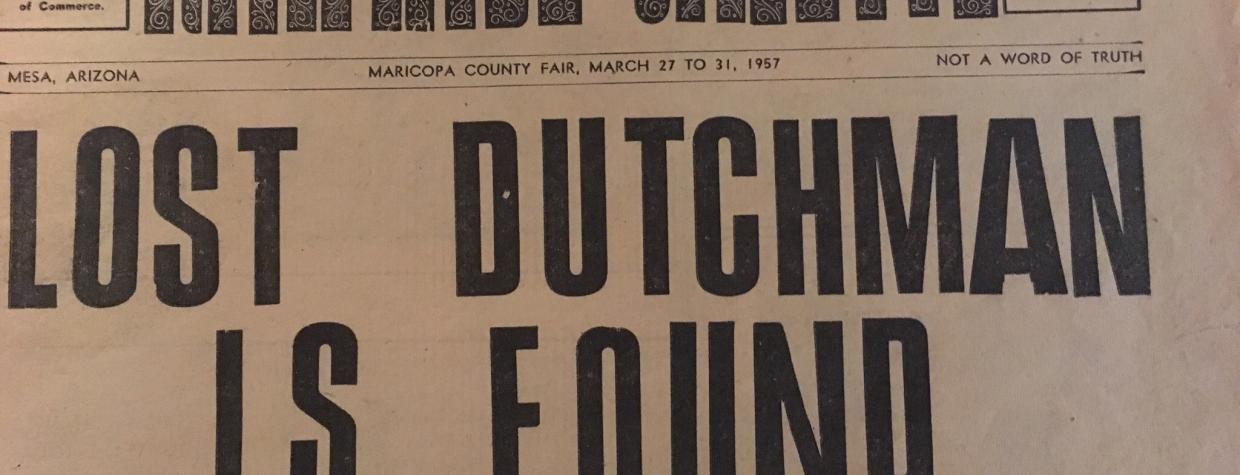By Brent Ruffner
The day started with a few ribs cooking over the fire and some Superstition Gold coffee.
Just before noon, the small group had had enough chitchat. Instead, they wanted to get off-road, to a new site where there was the promise of gold.
That site – just off the Peralta Trail in the Superstition Mountains — ended up being a hole where a mountain lion had apparently made its home. The area was covered in mountain lion scat.
The group of "Dutch hunters" was in the area early this month for the Dutch Hunter Rendezvous, an annual camping event where the public can pay homage and celebrate Jacob Waltz — a German man, now known as the "Dutchman," who supposedly found a $200 million gold mine in the Superstitions in the 1800s.
The trek, a few hours before the official event, seemed routine for most of the group, who head to the mountains for adventure. Members say you must look for indicators instead of walking by signs of what could be treasure.
“You never know what you will find,” Dutch hunter Wayne Tuttle said. “[The site was] right around the corner from what everyone is familiar with, and no one knew it was there.”
Tuttle, a cast member on the History Channel show Legend of the Superstition Mountains, is a member of the event’s sponsor, the Don’s Club of Phoenix — founded in 1931 by Phoenix YMCA members who developed a love for the mountains. The once-exclusive club was made up of young professionals and businessmen.
Members routinely dressed in outfits of the early Spanish dons and doñas while camping. For $3, the group bused people in from Washington Street in Phoenix to the western side of the Superstitions — at least a few hours' ride in 1935.
Customers received a miner’s lunch and a Spanish dinner at base camp with “all the coffee you can drink” that day. The program also featured two hikes in the afternoon. At one time, Don’s Club events featured performances from Hopi dancers and demonstrations by Navajo weavers.
In 1946, its members made President Harry Truman an honorary member of the club. They presented him with a sombrero in a picture that helped promote the club by landing on the pages of newspapers across the country.
During the Don’s Trek event, members lit up the night sky on most occasions. Until 2001, members would drop 1,600 pounds of burning charcoal off the ledges of the Dayside Cliffs – which were several hundred feet high — in a practice called Fire Falls followed by fireworks.
“Reading newspaper articles, you can tell how popular it was,” said Greg Davis, a Don’s member since the 1970s. “But times change.”
His uncle, Art Weber, was a physical education director for the YMCA in Phoenix and helped form the group.
Davis uses a 1,000-square-foot room to house decades of newspaper articles, books and collector’s items about the club and the Superstition Mountains. He has nine filing cabinets filled with records about his uncle’s club.
Tuttle, too, has helped keep tradition alive despite only a few families with children who attended this year’s event. Next year, the Rendezvous will celebrate its 15th year.
He remembers carrying a canteen full of Kool-Aid and a peanut butter sandwich when he was 8 years old. Afterward, he couldn’t wait to go back. “My whole mood changes when I’m in the mountains,” Tuttle said. “It’s a great feeling.”
Tuttle has passed on his love of the mountains to his oldest son, Trevor, 17, who regularly travels with Tuttle to film YouTube videos for their online show. A new episode of the show is posted on Facebook every other week.
Prospector Woody Wampler attended this year’s Rendezvous and wants to pass on his trade to younger generations. Wampler, who has been a prospector since 1970, said people often use bad practices when panning for gold. He said moving the gold pan in a fast, circular motion is a good way to cause the gold to fly out of the pan.
He offers classes for $50 per person at his Dewey-based business. “I want to pass on what I’ve learned,” Wampler said. “I don’t want it to go to the grave with me.”
The self-taught prospector said panning is a process where you want to work the layers of rock and minerals off by moving the pan in a gentle side-to-side motion. The goal is to separate the black sand from the gold once you’ve found an area in the dry Arizona creeks, he said — adding that most gold is found between 3 and 6 inches below the surface.
“[The gold] won’t be any deeper than the material moving down the creek,” Wampler said.
Wampler said he regularly donates his time to local school districts to and businesses such as Mortimer Family Farms to ensure traditions aren’t lost.
Starting January 18, the Don’s Club will host its annual Discovery Camp for students in the Apache Junction Unified School District. Students are bused in to the base camp near the Peralta Trailhead every Friday for six weeks. There, instruction lasts from 9 a.m. to 3 p.m. Still, it’s challenging to garner the interest of young people.
“It would sure be nice to get some young people interested in the club,” Davis said. “There’s not many. It’s getting tough. There’s too much other stuff going on these days.”
But Wampler is confident younger generations can become interested in the art of prospecting and can develop a curiousity about the mountains: “Families that play together, stay together.”
For more information about the Dutch Hunter Rendezvous, visit the group's website.

